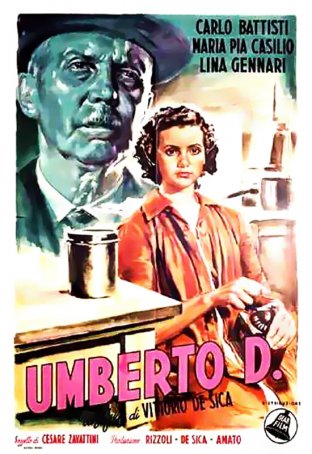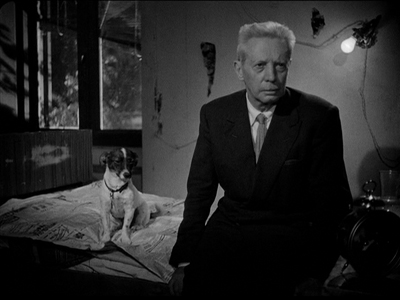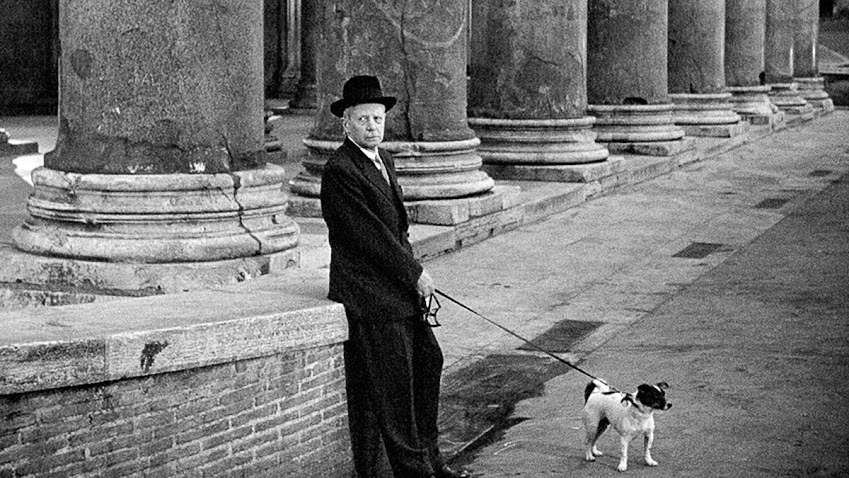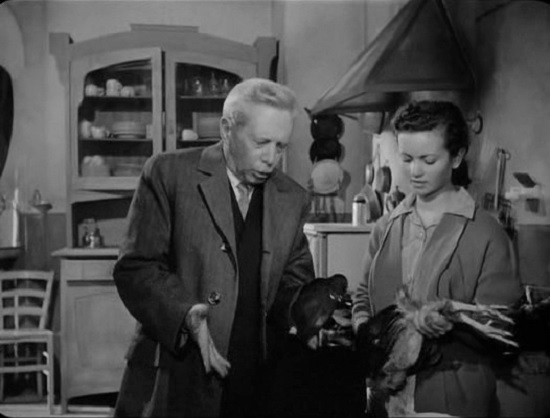Umberto D. (United Kingdom, 1952)
March 21, 2024
History has decreed that Umberto D., a 1952 film from celebrated Italian director Vittorio De Sica, is one of the best representations of neo-realism committed to film. (Ingmar Bergman called it a “favorite movie” and Martin Scorsese labeled it a “precious gift.”) The production works, like all such movies, because it presents believably human characters and avoids sentimentality in telling their stories. Umberto D. walks a line between slipping into melodrama and boring an audience with tepid storytelling. We relate to the characters, absorb the deeply rooted sense of melancholia that permeates the film, and exit before the movie overstays its welcome (it clocks in at a relatively svelte 90 minutes).
De Sica made Umberto D. with the shrapnel of World War II barely in the rearview mirror. The wounds were still raw and movies like this, which takes a stark, uncompromising look at the postwar social strata and eschews an upbeat ending, were detested by the public. Around the time of its release, Umberto D. was lauded by critics and the overseas “intelligencia,” but the Italian press was scathing and the box office receipts were nonexistent. In future years, De Sica acknowledged that his countrymen weren’t yet ready to watch Umberto D. It came “too soon.”
 The movie features only three characters of any import. The
title figure, Umberto Domenico Ferrari, is a pensioner trying to pay off his back
rent and avoid eviction from a cramped apartment. He is played by Carlo
Battisti, a university professor making his professional acting debut at the
age of 69. This is his one and only feature film as an actor. Supporting
performers include Maria (Maria Pia Casilio), a maid at Umberto’s apartment
building, and Antonia (Lina Gennari), the landlady. Maria Pia Casilio is, like
Battisti, a newcomer to film, although she used this as a springboard to start
a career. Her lightness of touch offers a counterpoint to Battisti’s gravitas.
Despite the seriousness of Maria’s situation, the actress brings a touch of
whimsy to the performance.
The movie features only three characters of any import. The
title figure, Umberto Domenico Ferrari, is a pensioner trying to pay off his back
rent and avoid eviction from a cramped apartment. He is played by Carlo
Battisti, a university professor making his professional acting debut at the
age of 69. This is his one and only feature film as an actor. Supporting
performers include Maria (Maria Pia Casilio), a maid at Umberto’s apartment
building, and Antonia (Lina Gennari), the landlady. Maria Pia Casilio is, like
Battisti, a newcomer to film, although she used this as a springboard to start
a career. Her lightness of touch offers a counterpoint to Battisti’s gravitas.
Despite the seriousness of Maria’s situation, the actress brings a touch of
whimsy to the performance.
As is often the case with neo-realism, plot is a secondary concern. Umberto D. is no exception in this regard; the focus is more on the central character and the circumstances in which he finds himself. The movie opens with Umberto engaged in a protest organized by pensioners who want the government to raise their monthly stipends. Umberto, a retired government worker, is already in debt to his landlady and, although he doesn’t appear to be deeply committed to the cause, recognizes that a raise might help him to remain in his current apartment. After selling a watch and some prized books, he makes some money but the landlady wants the entire amount. Maria, the maid, confesses to Umberto that she is three months pregnant and expects to lose her job once her condition is known.
 With the debt still hanging over him like a Sword of Damocles,
Umberto is admitted to a hospital with tonsillitis. The doctors dismiss his
condition as minor and send him home. He discovers that workers have already
begun tearing apart his room (the landlady having decided to expand her living
room to include Umberto’s quarters once he is evicted). Meanwhile, Maria has
lost his beloved dog, Flike, who had been in her care while he was indisposed. Umberto
embarks upon a search for the missing pooch that ends with a happy reunion at
the dog pound. No amount of puppy love, however, can provide the thousands of
lire needed to pay the back rent and Umberto soon finds himself homeless on the
streets of Rome.
With the debt still hanging over him like a Sword of Damocles,
Umberto is admitted to a hospital with tonsillitis. The doctors dismiss his
condition as minor and send him home. He discovers that workers have already
begun tearing apart his room (the landlady having decided to expand her living
room to include Umberto’s quarters once he is evicted). Meanwhile, Maria has
lost his beloved dog, Flike, who had been in her care while he was indisposed. Umberto
embarks upon a search for the missing pooch that ends with a happy reunion at
the dog pound. No amount of puppy love, however, can provide the thousands of
lire needed to pay the back rent and Umberto soon finds himself homeless on the
streets of Rome.
 At the time of its creation, Umberto D. could be seen
as both a clear-eyed examination of Italy in the wake of World War II and a
parable about the rapaciousness of greed. The landlady, who is pursuing wealth
and status, is presented as a villain. And Umberto, despite a series of unappealing
qualities, is sympathetic. Umberto D. shares a common theme with Yasujiro
Ozu’s masterful Tokyo Story (which was made one year after this movie):
both films explore society’s growing disdain for the aged – a post-war desire
by the younger generation to sweep their parents and grandparents to the side
as unwanted and useless (and perhaps blameworthy for the previous decade’s
carnage). The concept of venerating and caring for older citizens, once a bulwark
of human civilization, became one casualty of the turmoil of war and recovery.
At the time of its creation, Umberto D. could be seen
as both a clear-eyed examination of Italy in the wake of World War II and a
parable about the rapaciousness of greed. The landlady, who is pursuing wealth
and status, is presented as a villain. And Umberto, despite a series of unappealing
qualities, is sympathetic. Umberto D. shares a common theme with Yasujiro
Ozu’s masterful Tokyo Story (which was made one year after this movie):
both films explore society’s growing disdain for the aged – a post-war desire
by the younger generation to sweep their parents and grandparents to the side
as unwanted and useless (and perhaps blameworthy for the previous decade’s
carnage). The concept of venerating and caring for older citizens, once a bulwark
of human civilization, became one casualty of the turmoil of war and recovery.
Umberto D. is an almost-perfect slice-of-life. It has no true beginning and no firm ending. It fades in and fades out, affording us an opportunity to spend some time with one old man and get to know him and the world in which he lives. As with many older films, the value of this approach – a contemporaneous look at minutia that many other movies don’t provide – is amplified. Umberto D. provides a window into the past – an opportunity to experience an unvarnished perspective of things more often represented in sepia-tinged photographs. It’s often said that good films “don’t age.” In this case, the quality of aging is a strength.
Umberto D. (United Kingdom, 1952)
Cast: Carlo Battisti, Maria Pia Casilio, Lina Gennari
Home Release Date: 2024-03-21
Screenplay: Cesare Zavattini
Cinematography: G. R. Aldo
Music: Alessandro Cicognini
U.S. Distributor: Dear Films
- (There are no more better movies of Carlo Battisti)
- (There are no more worst movies of Carlo Battisti)
- (There are no more better movies of Maria Pia Casilio)
- (There are no more worst movies of Maria Pia Casilio)
- (There are no more better movies of Lina Gennari)
- (There are no more worst movies of Lina Gennari)
Comments